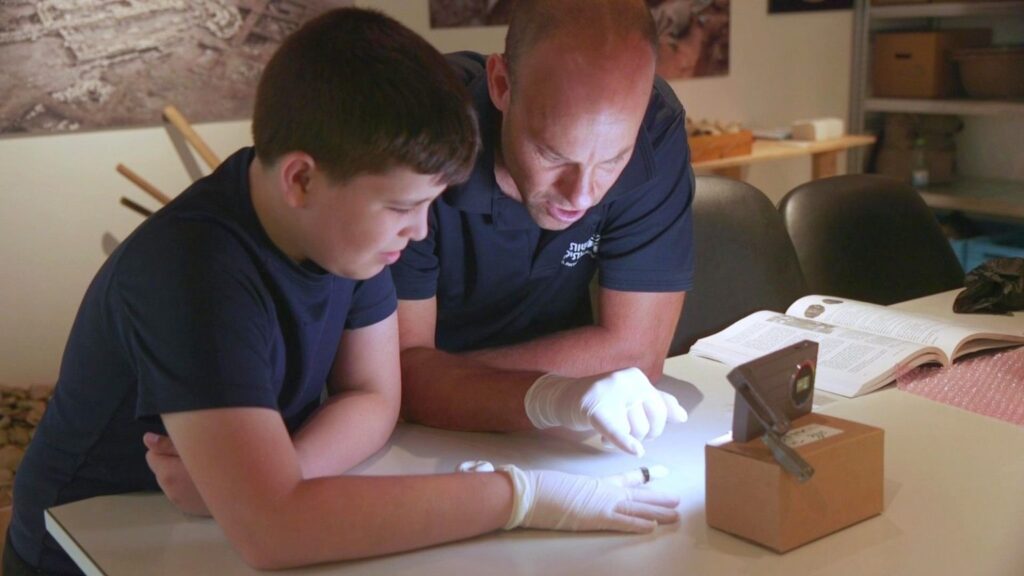Photo: Emil Edjam, Israel Antiquities Authority
Unexpected Discovery
When 13-year-old Yair Weitzman went for a walk near his home with his father, who had just returned from four months of military service, he could not have imagined that the day would end with a rare discovery—a bronze ring engraved with the image of the Greek goddess Athena (or Minerva in Roman mythology)—and a certificate for civic responsibility.
Discovery Story
Weitzman explained that he went for a walk near his house to spend quality time with his father. During the walk, near an ancient quarry in Carmel, he came across an object that piqued his interest. “I’m interested in fossils and stones and like to collect them,” Weitzman said. “During the walk, I noticed a small green object and picked it up. It had corrosion on it, so I initially thought it was a bolt nut. I thought about melting it down, but luckily I realized it was a ring. At home, I noticed a figure on it. At first, I thought it was a warrior.”
Consultation with Experts
The family contacted Nir Distelfeld, an inspector from the Israel Antiquities Authority’s Robbery Prevention Unit, who transferred the ring to the national treasury. The ring was examined by Professor Shua Amorai-Stark, an expert in ancient rings and amulets from the Kaye College, who immediately recognized it as a priceless artifact.
Description of the Find
Distelfeld and Dr. Eitan Klein from the Israel Antiquities Authority’s Robbery Prevention Unit describe the find: “The well-preserved ring features a naked figure wearing a helmet. In one hand, she holds a shield, and in the other, a spear. Weitzman’s identification of the figure as a warrior is quite accurate. It is most likely Minerva from Roman mythology, also known as Athena in Greek mythology. This goddess, who was very popular during the Roman period in Israel, is considered the goddess of war and military strategy as well as wisdom.”
Details of the Find
According to them, the ring, likely made of bronze, belonged to a woman or girl and dates back to the Roman period (2nd-3rd century CE). It was found near the archaeological site of Khirbat Shelah, on a hill where ruins of a Roman villa remain and close to an ancient stone quarry. At the edge of the quarry, there are two burial openings. “It is possible that the ring belonged to a woman who lived in that villa,” the researchers say. Other possibilities include that the ring belonged to a quarry worker or was a funerary offering in nearby graves.

Dr. Eitan Klein and Yair Weitzman Photo: Emil Elgem, Israel Antiquities Authority
Historical Significance of Khirbat Shelah
Khirbat Shelah, located in the heart of the Carmel Mountains, is surrounded on three sides by the Oren Stream, and nearby is the Ain Alon spring. The site has been previously studied by researchers from the British Research Fund, Professor Ruth Amiran, and a team from Bar-Ilan University led by Professor Shimon Dar. “The ring adds new data to previous excavations and surveys conducted at Khirbat Shelah, shedding new light on the site,” conclude Distelfeld and Dr. Klein.
Recognition for Civic Responsibility
Following the discovery of the ring, Weitzman and his family were invited to tour the National Archaeological Center of Israel in Jerusalem, where he was presented with a certificate for his civic responsibility.
Comments from the Authorities
Israel Antiquities Authority Director Eli Eskosido stated: “Yair’s act of immediately reporting the discovery and turning over the ring to the national treasury demonstrates responsibility and respect for our past. We were pleased to host Yair and his family and award him a badge created from the ring. Yair told us he dreams of becoming an archaeologist, and we will reserve a place of honor for him.” The ring will be displayed to the public as part of summer tours at the National Archaeological Center.
Source: colbonews
















